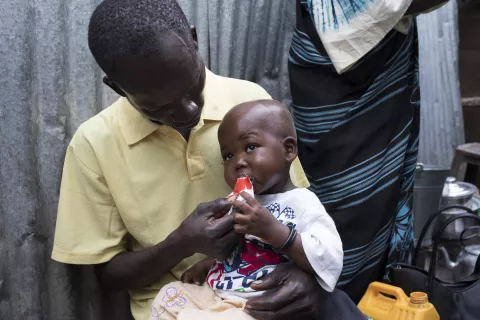90 million children's lives saved since 1990
China ahead of schedule despite wide disparities
- Available in:
- 中文
- English
BEIJING, 13 September 2013 – Some 90 million children's lives have been saved over the past two decades thanks to concerted global and national action for children, according to a new report by UNICEF.
The annual number of under-five deaths has fallen from 12.6 million in 1990 to 6.6 million in 2012. The reductions are due to more effective and affordable treatments, improvements in mothers' nutrition and education, innovations in bringing critical services to poor and excluded people and sustained political commitment.
According to the report, China's child mortality rate has been reduced by 74 per cent since 1990, surpassing the Millennium Development Goal for 2015.
Yet, without faster progress in all regions to save children's lives, it will take another 13 years, until 2028, before the world will meet the promise of Millennium Development Goal 4 to reduce child mortality by two-thirds by 2015.
The cost of not redoubling efforts is alarmingly high: as many as 35 million more children will have died by 2028. Had the world met the 2015 target and continued it rate, these millions of children would be alive.
According to the report, with 258,000 under-five deaths per year, China has the fifth highest number globally. China's under-five mortality rate has fallen from 61 per thousand in 1991 to 15 per thousand in 2011, according to National Health and Family Planning Commission statistics.
“Yes, we should celebrate the progress,” said Anthony Lake, UNICEF Executive Director. “But how can we celebrate when there is so much more to do before we reach the goal? And we can speed up the progress - we know how, but we need to act with a renewed sense of urgency,” he said.
While China's national child mortality rate is low, wide gaps remain between urban and rural areas. Far western provinces experience more than 2 times greater rates of child mortality than urbanized eastern provinces.
The 2013 Progress Report on Committing to Child Survival: A Promise Renewed examines trends in child mortality since 1990, analyses the main causes of under-five deaths, and highlights national and global efforts to save children's lives.
The progress made to date is due to the collective efforts of governments, civil society and the private sector, as well as the increase in affordable, evidence-based interventions, such as insecticide-treated mosquito nets, medicines, vaccines, proper breastfeeding, nutritional supplements and therapeutic food, rehydration treatment for diarrhoea, and improved access to safe water and sanitation, among others.
The report shows sharp reductions in preventable child deaths across all regions of the world, and at all levels of national income, including low-income countries. In fact, some of the world's poorest countries have made the strongest gains in child survival since 1990. A few low-income countries with high child mortality rates, such as Bangladesh, Ethiopia, Liberia, Malawi, Nepal and United Republic of Tanzania, have already reduced their under-five death rates by two-thirds or more since 1990, reaching Millennium Development Goal 4 for the reduction of child deaths ahead of the 2015 deadline.
Globally, the pace of decline has accelerated with the annual rate of decline tripling since the 1990s. Sub-Saharan Africa has also accelerated its rate of decline, with its annual rate of reduction increased more than more than fivefold since the early 1990s. In the past seven years, Eastern and Southern Africa has been among the best performing regions in the world, reducing under-five mortality at an annual rate of 5.3 per cent in 2005-2012.
By contrast, West and Central Africa recorded the lowest level of progress on child survival, compared to other regions around the globe. The region also has the highest rate of mortality, with almost one in every eight children dying before the age of five. West and Central Africa has had virtually no reduction in its annual number of child deaths since 1990.
Pneumonia, diarrhoea, and malaria remain leading causes of child deaths globally, claiming the lives of around 6,000 children under five each day. Undernutrition contributes almost half of these deaths.
The first month of life is the most precarious for a young child. In 2012,close to three million babies died during the first month of life, mostly from easily preventable causes.
Reversing these devastating trends requires immediate action on multiple fronts, as outlined in the Millennium Development Goals - reducing poverty, decreasing maternal mortality, boosting education and gender equality, and promoting environmental sustainability.
“Progress can and must be made,” said Mr. Lake. “When concerted action, sound strategies, adequate resources and strong political will are harnessed in support of child and maternal survival, dramatic reductions in child mortality aren't just feasible, they are morally imperative.”
About Committing to Child Survival: A Promise Renewed
A Promise Renewed is a global movement that seeks to advance Every Woman Every Child – a strategy launched by United Nations Secretary-General Ban Ki-moon to mobilize and intensify global action to improve the health of women and children around – through action and advocacy to accelerate reductions in preventable maternal, newborn and child deaths.
The movement emerged from the Child Survival Call to Action, a high-level forum convened in June 2012 by the Governments of Ethiopia, India and the United States, in collaboration with UNICEF, to examine ways to spur progress on child survival. Partners from government, civil society and the private sector emerged from the Call to Action forum with a revitalized commitment to child survival.
Attention broadcasters: Recent video news stories and b-roll from Bangladesh, Brazil, Ethiopia and Uganda will be available at http://weshare.unicef.org/mediaresources
Media contacts
About UNICEF
UNICEF works in some of the world's toughest places, to reach the world's most disadvantaged children. Across 190 countries and territories, we work for every child, everywhere, to build a better world for everyone. For more information about UNICEF and its work for children visit www.unicef.org.
| Visit UNICEF China website: www.unicef.cn Follow us on Sina Weibo: http://weibo.com/unicefchina Tencent Weibo: http://t.qq.com/unicef Wechat: unicefchina |



